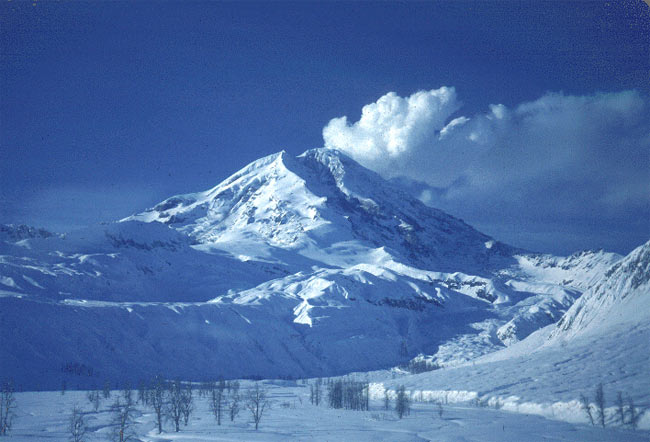Inside Alaska's Explosive Redoubt Volcano

Mount Redoubt volcano in Alaska could erupt within days to weeks, say scientists at the U.S. Geological Survey, amazing the rest of us with their certainty.
Here's what makes them so sure: Magma rising toward the surface from beneath a volcano like Redoubt can cause earthquakes and other seismic rumblings. And seismic activity at Redoubt, which is 106 miles (170 km) southwest of Anchorage, has increased recently.
"If you're going to bring magma to the surface you've got to break rock, and every time rocks break at the subsurface beneath a volcano, that's an earthquake," said volcanologist Charles Mandeville of the American Museum of Natural History in New York. "They're recording a whole bunch of earthquakes almost continuously right now," he said, referring to scientists at the Alaska Volcano Observatory in Anchorage.
Ring of Fire
There are more than 40 active volcanoes in Alaska, many of which are situated on the Aleutian Islands in the Pacific Ocean. Redoubt's neighboring volcano Mount Augustine (located 177 miles, or 285 km southwest of Anchorage) last blew its top in 2006.
In fact, the Aleutian Island chain makes up the northern part of the Ring of Fire, which circles the Pacific Ocean and produces frequent activity along the coasts and interior regions of North and South American and Japan. The Ring of Fire is considered one of the most volcanically and seismically active regions in the world.
The Aleutian Islands are themselves the result of volcanic activity, forming as the Pacific plate dives beneath, or "subducts," the North American plate. More than 75 percent of the world's volcanoes lie along the Ring of Fire, where tectonic plates dive beneath other plates.
Sign up for the Live Science daily newsletter now
Get the world’s most fascinating discoveries delivered straight to your inbox.
Need to vent
Mandeville, who has studied Mount Augustine volcano, said that the Alaska-based scientists are reporting both more earthquakes and higher intensity ones at Redoubt in the past eight hours. "The amount that the ground is actually shaking is increasing," Mandeville told LiveScience.
At this point, scientists from the Alaska Volcano Observatory are monitoring Redoubt around the clock. Redoubt rises to a height of 10,197 feet (3,108 meters). To predict a coming eruption, scientists also watch for certain gases, such as carbon dioxide, sulfur dioxide and hydrogen sulfide, emanating out of a vent along the volcano, Mandeville said.
"It's in a period that we call restlessness," said U.S. Geological Survey Volcano Hazards Program Coordinator John Eichelberger, in a recent podcast. "We expect an eruption in a matter of days or weeks. The strongest evidence for this is small earthquakes indicative of the movement of gas pressurizing the interior of the volcano."
Predicting what might come includes looking at Redoubt's past.
The volcano last erupted explosively nearly 20 years ago, beginning in December 1989 and lasting for months, sending ash plumes 40,000 feet (12,000 meters) into the air and causing engine failure in a 747 jet, which eventually landed safely. Ash also interrupted commercial air traffic into and out of Anchorage.
"The mud flows actually inundated an oil storage facility near Cook Inlet," Eichelberger said. "Barriers around the facility have been strengthened so again there is lessened risk, but this shows the kind of events that occur."
Why Redoubt erupts so explosively
From the most recent eruption of Redoubt, scientists identified certain types of rocks within the magma, finding the magma is made up of a lot of silica. Magma chockfull of silica is viscous (think warm, gooey taffy) and traps lots of gases. Only when that magma gets to the surface, where pressure decreases, can that gas exit, similar to opening up a shaken soda.
"With those types of magmas you can get a very stiff rock foam rising to the surface, and the only way the gases can eventually come out when they encounter lower pressure is to literally blow the foam apart," Mandeville said.
Magma from the Hawaiian volcanoes like Mount Kilauea is typically basaltic, which contains much less silica and is much less viscous. That means gases can percolate out of the magma much easier, leading to calmer eruptions.
- What's the Largest Recorded Volcanic Eruption?
- Where Are Most of Earth's Volcanoes?
- Volcano Quiz: Part I
Jeanna Bryner is managing editor of Scientific American. Previously she was editor in chief of Live Science and, prior to that, an editor at Scholastic's Science World magazine. Bryner has an English degree from Salisbury University, a master's degree in biogeochemistry and environmental sciences from the University of Maryland and a graduate science journalism degree from New York University. She has worked as a biologist in Florida, where she monitored wetlands and did field surveys for endangered species, including the gorgeous Florida Scrub Jay. She also received an ocean sciences journalism fellowship from the Woods Hole Oceanographic Institution. She is a firm believer that science is for everyone and that just about everything can be viewed through the lens of science.









